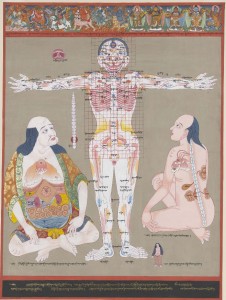 Seventeenth-century Tibet witnessed a blossoming of medical knowledge, with the construction of a monastic medical college and the penning of several influential medical texts.
Seventeenth-century Tibet witnessed a blossoming of medical knowledge, with the construction of a monastic medical college and the penning of several influential medical texts.
Tibetan anatomists counted a total of 360 bones in the human body—significantly more than the 206 bones described in Western medical books. This disparity stems from the fact that Tibetans counted cartilage, as well as fingernails and toenails, to be bones. Other anatomical estimates reveal similar inconsistencies, such as the Tibetan calculation of 21,000 hairs on the human head, while modern medicine estimates that the scalp has an average of 100,000 hair follicles.
The paintings were commissioned by the fifth Dalai Lama’s regent, Desi Sangye Gyatso, who stepped in as interim ruler of Tibet after the Dalai Lama died in 1682. Gyatso placed great value on the accuracy of the illustrations, frequently consulting medical specialists and encouraging the use of fresh
corpses as models for the anatomical paintings. But he also left a lot of room for symbolic creativity, as is apparent in the depiction of internal organs such as the stomach (red diamond), the small intestines (red swirls), and the large intestine (blue waves).